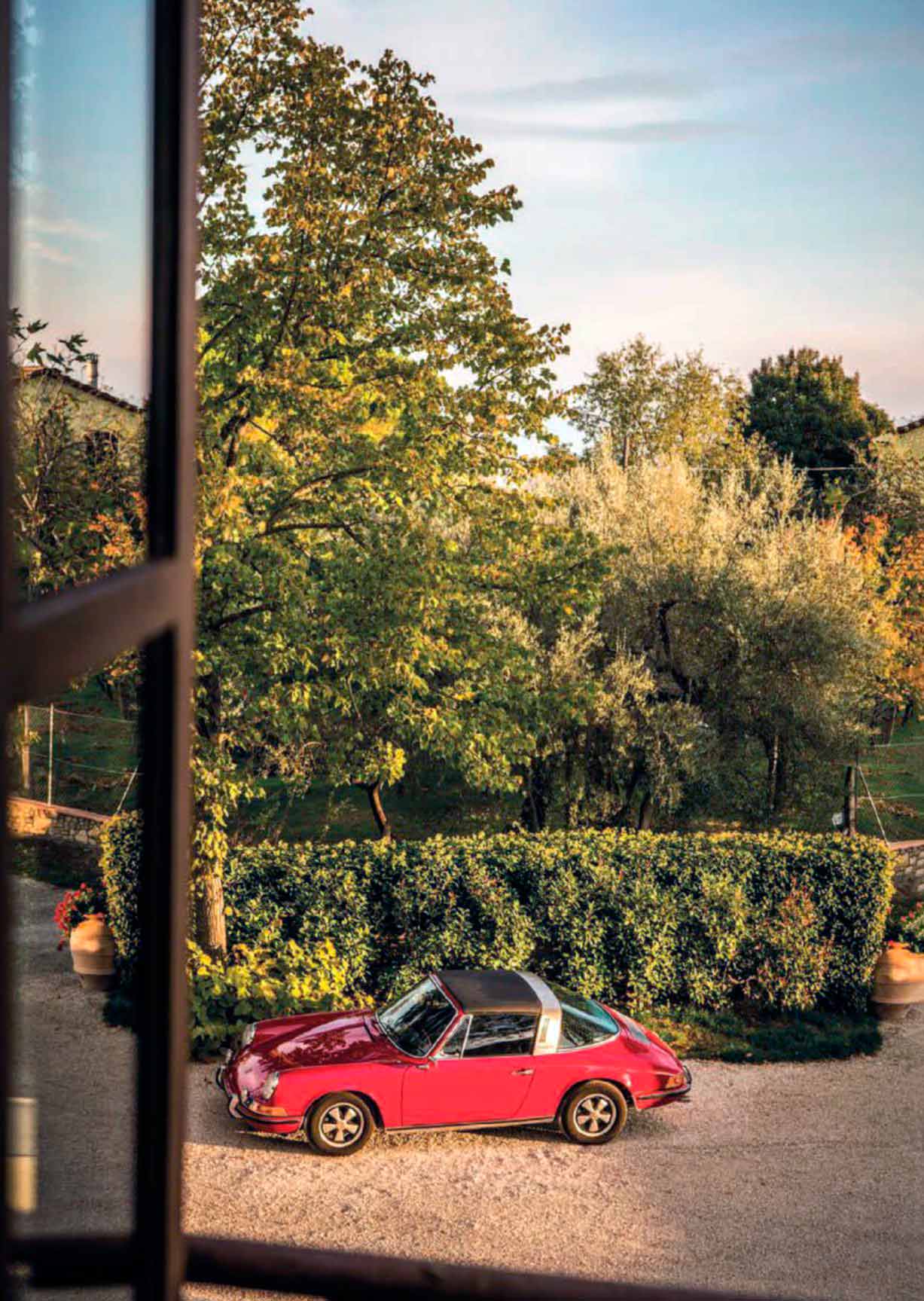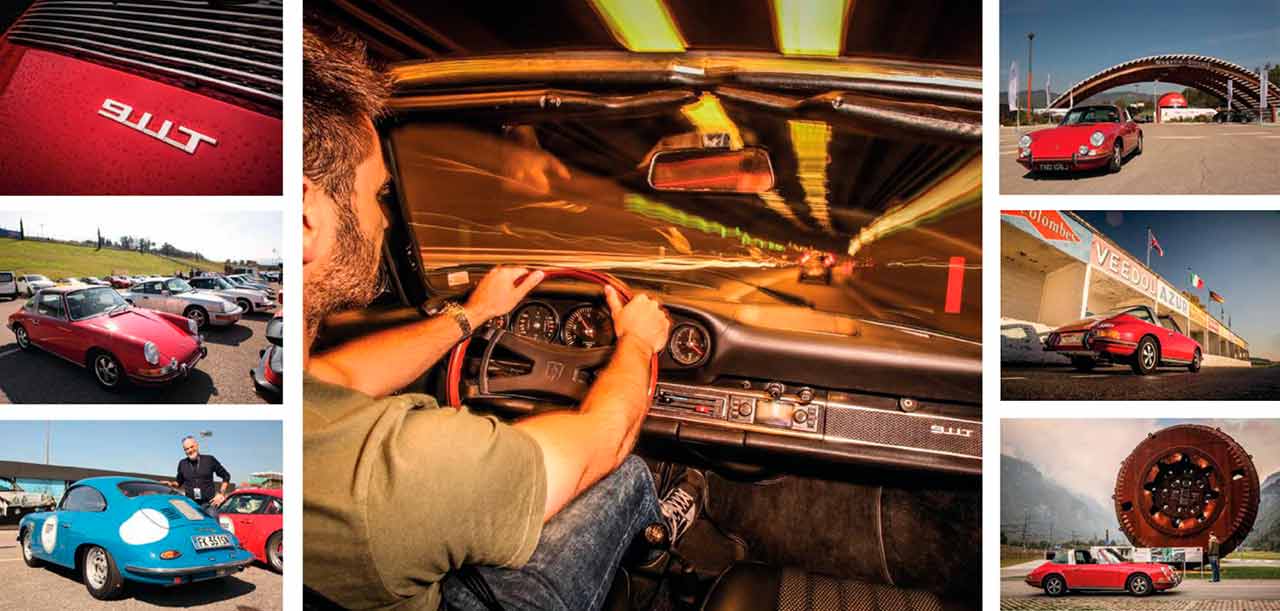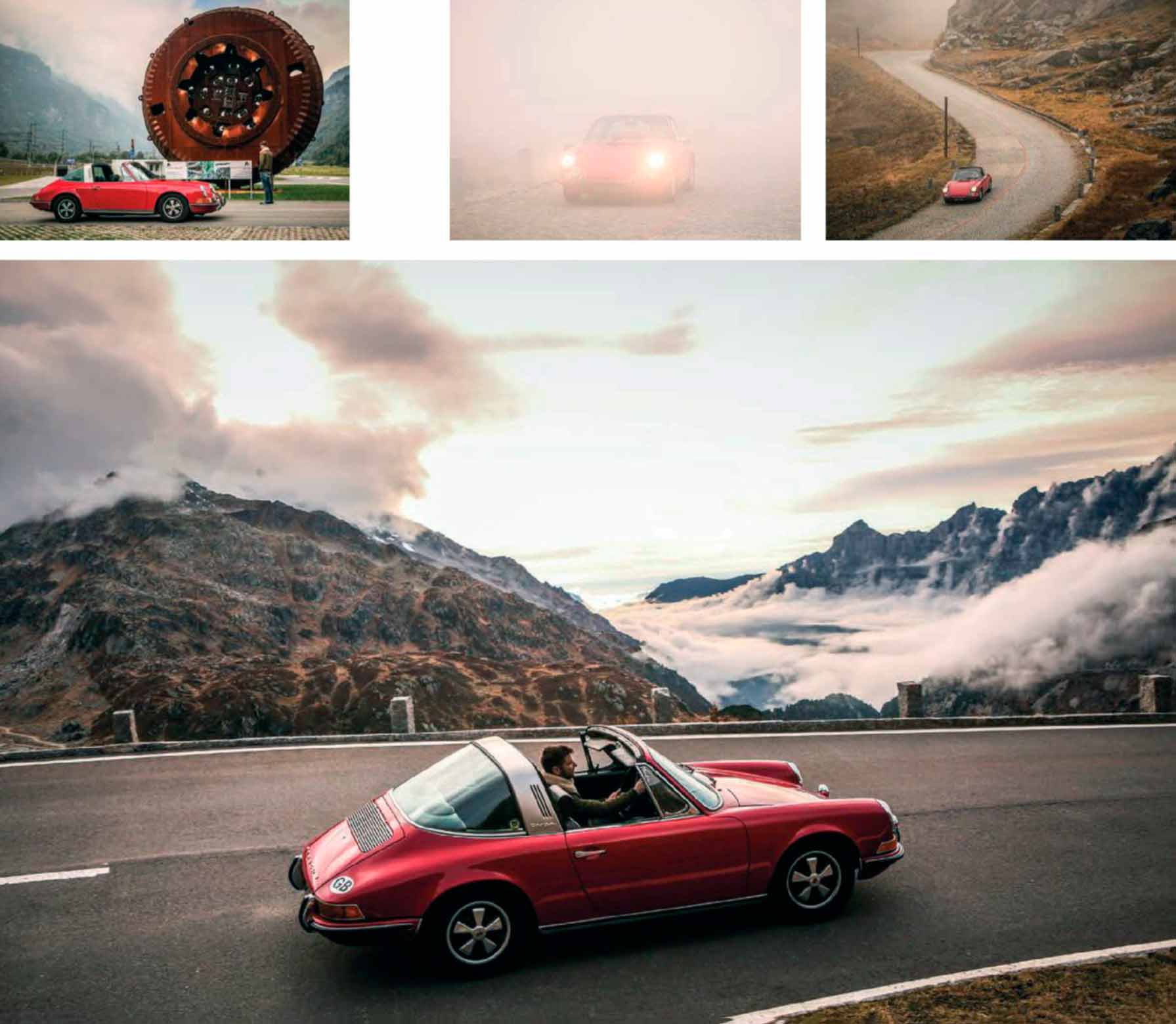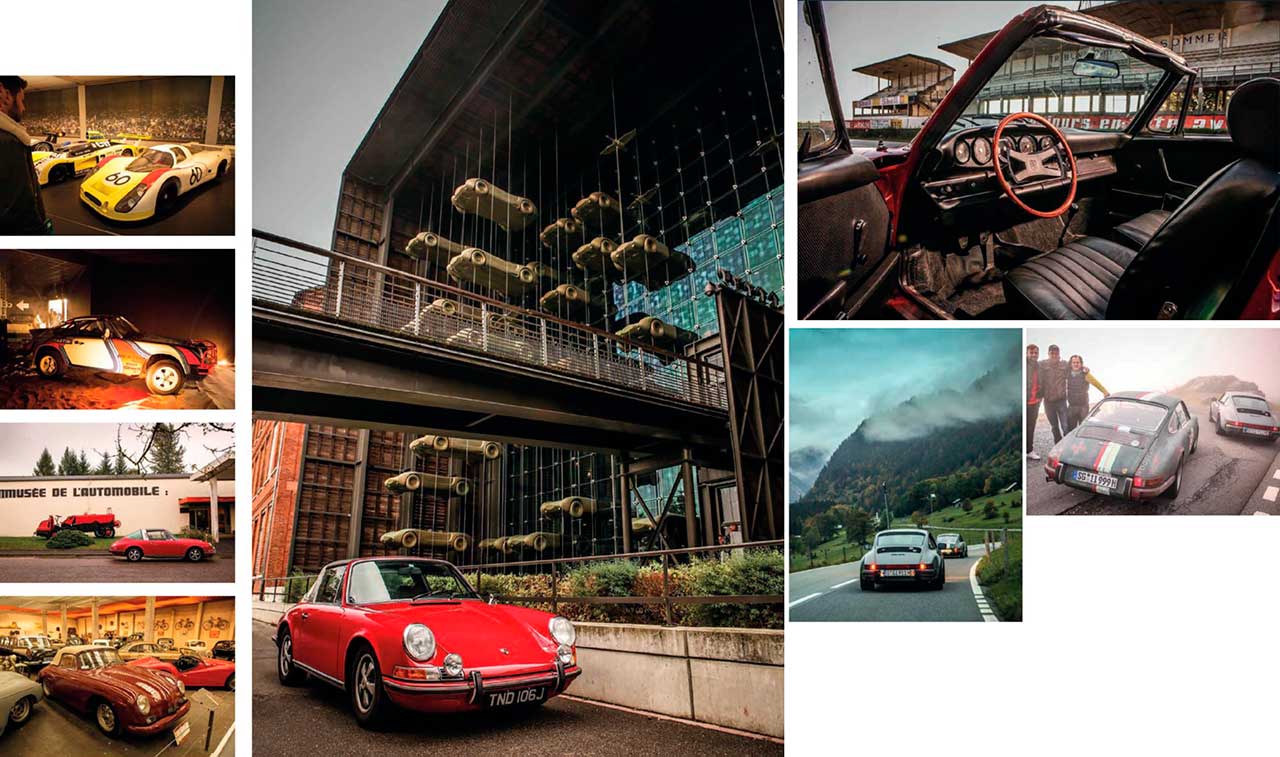
On top of the world. You don’t just get given the keys to a classic Porsche 911 with no strings attached, do you? Greg MacLeman did, and made the most of it with an epic European road trip. Photography Tony Baker.
Porsche 911 Our top photos Dream Drive 2000 miles across Europe in a perfect Targa.
HEAD IN THE CLOUDS Our man Greg sets off on the delivery run of a lifetime. Porsche 911 road trip. Lifting the lid on the underrated targa with a memorable run across Europe.
The world of publishing has changed a lot since the 1970s. Print was king, magazines had the ear of manufacturers, and office parties resembled the last days of Rome. As a journalist who started his career after the turn of the millennium, though, I was convinced that the epic tales of trans-European derring-do recounted by the likes of Mel Nichols had gone the same way as the liquid lunch: consigned to the history books and dog-eared copies of Car. Then I received a call from a reader who had a problem that he thought we might be able to help with: how to get a 1971 Porsche 911 targa from central Italy to the UK in three days.

Of course, we jumped at the chance, especially when we realised that Mugello Circuit, just a few hours north of his Italian pad, would host a huge Porsche Festival the day after we arrived. The 911 targa hasn’t always been as desirable as it is today. Like the ‘Sabrinas’ of the MGB and the open headlamps of the Series 1½ E-type before that, the 911 targa fell foul of US Federal Regulations – or at least the threat of them.
‘TIME HAS BEEN KIND TO THE TARGA, AND THE BRUSHED-STEEL HOOP GIVES THE CAR ITS OWN CHARACTER’
Concerned that a ‘proper’ convertible would be outlawed in the States, Porsche opted to add a brushed-stainless-steel rollover bar that, to many eyes, detracted from the organic lines of the tin-top 911. But the passing of time has been kind to the targa and, far from spoiling an already pretty car, the tall hoop and glasshouse combination imbue the open version with its own character, in the process creating a model that was perfectly suited to grand touring.

In its modest 125bhp ‘T’ tune, this 2.2 targa was never going to set the world alight in terms of outright performance, but it comes into its own in the Umbrian countryside, where the torque of the carburetted engine really hauls, and the simple-to-operate pop-out roof section opens up occupants to the sights and smells of the outside world, but without the buffeting and wind noise of a full convertible.
Given Stuttgart’s nod to North American legislation, it should come as no surprise that ‘our’ targa was delivered new to the States, spending much of its time in the rustbelt; look closely and you’ll see a parking permit for RV manufacturer Coachmen Indiana in the window, alongside a sticker for Williams Crawford, the marque specialist that worked on the car after it came to the UK.
‘AS THE ROAD NARROWS THE GRADIENT INCREASES, AND THE GUTSY FLAT-SIX WORKS HARD TO KEEP PACE’
“We picked it up straight from the docks, before the owner had even seen it,” says Adrian Crawford. “It was bright yellow, and we quickly realised that what Americans call a ‘driver’ is very different to our description of the same!” Restoration manager Graham Kidd then spearheaded a light rebuild, which included making the car safe and properly sorting a litany of poor repairs prior to a colour change to Ruby Red, a 356 shade that suits the targa well. “We were working to a tight schedule,” says Crawford. “After a couple of hundred shakedown miles, the owner drove it straight to Italy!

We’re looking forward to getting it back to continue working on the car, with upgrades that will include fitting air-conditioning.”
Though the restoration was largely cosmetic, the Porsche drives incredibly well – like a sharp Savile Row suit paired with your most comfortable slippers – and we feel at home as soon as we climb aboard. After a sighting drive around the twisting back roads of Umbria, our first stop is the Mugello Circuit in Tuscany. Despite being the property of Ferrari since it was opened in 1974, the 5.2km track plays host to the Porsche Club Italia’s annual Porsche Festival, and the sun-drenched paddock area is packed with every model imaginable, from brutal 914-6 to this year’s Le Mans contender, the latter courtesy of Porsche Classic. Also on loan from the Stuttgart museum is a stunning 1955 550 Spyder – complete with aero wing fitted for the Nürburgring 1000km – that was shown at Pebble Beach in 2015 and Villa d’Este in 2016, as is a mighty 911 GT1, a Jägermeister-liveried 934 turbo racer and a 993 GT2.

But it’s the private machines that really get us excited, chief among them being Andrea Coriani’s 1961 356 Super 90. “This is the car’s first outing,” he enthuses. “I bought the Porsche 356 three years ago and have just finished the restoration. It was originally built to contest a racing championship in Sweden, which is where I found it. It’s now fully restored and is the perfect model for me!” The stunning 356 joins a dazzling array of visitors’ cars, which comprises a full range of air-cooled 911s, dozens of watercooled examples and a number of transaxle models, including Porsche 968, Porsche 928 and Porsche 944.
There’s just enough time for an ill-advised Lampredotto – allegedly a Florentine ‘delicacy’, but later discovered to be tripe – before hitting the road again. Hoping to make Lake Como before nightfall, we vary our route between the free-flowing motorways and quieter back roads, stopping for cappuccinos at regular intervals. As the terrain becomes more hilly and the signature cypress trees give way to signs of northern industry, we reach a series of lengthy tunnels: the perfect opportunity to revel in the car’s flat-six soundtrack. With left-hand-drive, overtaking is a breeze and we spend the afternoon with the throttle pinned, the jagged line of Alpine mountains rising slowly as day gives way to dusk.

We’re thankful to finally stop, washing down hearty pizza with beer before turning in. Most of the tourists who visit Como do so in the hope of stealing a glimpse of Hollywood megastar and peddler of instant coffee solutions George Clooney, but to the petrolhead the lake is more synonymous with Concorso d’Eleganza Villa d’Este. The concours holds a public day at nearby Villa Erba, but we’re barred from such expensive establishments. The southern side of the lake is busy, anyway, and we spend a good hour or so in traffic around Como before heading up the eastern shore in search of a view.
Houses and villages line and overhang the road, creating a tunnel of noise as our 911’s exhaust reverberates around the walls, which at points become so narrow that we breathe in as we pass oncoming traffic. In typical Italian fashion no one slows down, so we too press on, revelling in the air-cooled clatter as we fire up through the gears. The 911 is more comfortable at pace, its six-cylinder engine bucking at low speeds.

The further north we drive, the higher we seem to climb, until the sailing boats and luxury Riva launches become like toys in a bath far below. Getting away from the narrow lakeside road requires an ascent up a severe incline, and a number of back-to-back hairpin bends that leave us praying not to meet anyone on their way down. We head west at the lakeside village of Menaggio, and for the first time set our sights on Lake Lugano, a vast body of water that straddles the border with neighbouring Switzerland.
As soon as we cross the frontier there’s a chance to fill up with fuel – it’s noticeably cheaper here than in Italy, and the road on the Swiss side is lined with service stations. Without a motorway vignette we decide to stick to smaller roads as we head north, climbing gradually higher and passing through increasingly rural towns and villages that, far from the Alpine ideal, seem starkly industrial. The landscape eventually opens up as we pass through a deep ravine lined with mountains, though the incredible scenery is juxtaposed against a Brutalist building shadowed by the enormous drill bit from ‘Heidi’ – one of four 450m-long boring machines used to excavate the 57km Gotthard Base Tunnel, the world’s longest rail tunnel.

Most of the motorway traffic funnels towards another underground route, which bypasses the windswept high roads, but we head for the St Gotthard Pass, a winding section of road that crosses the peaks of the southern Alps. As the strip of tarmac narrows, the gradient increases and the gutsy 2.2-litre flat-six works harder to keep pace, forcing us to drop down to second gear for tight switchbacks. The weather also begins to close in. The dark and foreboding clouds we spotted from the valley floor become thicker with every metre, the temperature plummetting at a rate of 1º per 100m of elevation. In no time we’re among the clouds, snow markers at the roadside obscured while cars fore and aft disappear into the murk. Despite the worsening conditions, we steer the Porsche off the Armcolined trail, away from the company of moderns and onto the cobbled surface of the original route, which runs alongside the newer passage.
Metal railings give way to concrete markers and the clouds ease slightly, though the spectacular peaks and snow-capped mountains are still draped in an impenetrable blanket.

After reaching the crest of the 2108m pass and its unsettling combination of sheer drops and claustrophobic, menacing weather, the road descends towards a series of tunnels littered with roadworks and red lights that impede our progress. The mood in the car is flat and the disappointment at the busy, cloud-wreathed pass is difficult to disguise as we point the 911 towards the Susten Pass, a route built during WW2 at an even greater height than that we’ve just traversed. Just over a mile later the road again arcs upwards, hugging the mountainside closer than before with sharper turns that require a deal more concentration. We’re on our own for this segment and, while the sunlight is beginning to break through in places, the majesty of our surroundings is still frustratingly out of sight. Until, that is, we enter another tunnel.
The bright light at the end of the short stretch gives hope, but it isn’t until we break through to the other side of the mountain that an incredible vista stretches out before us. Shafts of sunlight streak across the blue sky, lighting the clouds from above to a brilliant white, and turning the vast meltwater lake at the foot of the 4km-long Stein Glacier an ethereal shade of blue.
After moving the car closer to the lake for a photo opportunity, the bank of cloud that had so caught photographer Baker’s eye begins to roll up the mountainside, and before long the entire view is consumed and visibility drops away. Just as we’re packing up to move on, the unmistakable thrum of a flat-six – and then a second – fills the valley, and a 1987 Carrera 3.2 and ’1968 911 pull up alongside. The cars are driven by Porsche nuts from Germany – Marc Küllenburg, Tommi Brkovic and Gregor Mikolaschek – and within seconds we’re chatting about all things air-cooled. While the Carrera is as it was when it left the factory, the earlier car – imported from California by Küllenberg – has been modified extensively, with a 270bhp, 2.7-litre engine.

With the light fading fast we stow our equipment, replace the roof panel and follow our new friends down the mountain, catching up with the pair at a set of lights before giving chase through a tunnel. Despite its entry-level spec, the targa is quick enough to keep up – just about – and for the next few miles we bob and weave to carry as much speed as possible through the tight hairpins and long sweepers. The Germans’ cars are noticeably faster, and after a while we lose their tail-lights around another bend and ease off before getting too close to our 911’s limit – not something we’re keen to discover on these misty mountain roads, lined with shadowy trees and sharp drops. Both lead cars eventually pull over for another photo session but, with the darkness now near-complete and still a few more hours’ journey until we reach our overnight stop at Lake Lucerne, we beep our horn and blast off into the night to make up some ground.
‘THE ROUTE WINDS THROUGH VILLAGES AND VINEYARDS, AND THE SCENERY IS BREATHTAKING’
Still reeling from the cost of our short stay in Switzerland, we decide to set off early and clear as much of the country as we can, stopping only for fuel on the way to Mulhouse and the celebrated Cité de l’Automobile – formerly known as the Schlumpf Collection. The museum houses just a handful of Porsches, which become lost in a sea of pre-war Bugattis – the result of an obsessive drive by the Schlumpf brothers to buy every Bug they could lay their hands on. We’re also struck by the number of Gordinis, which share the Bugattis’ French racing blue livery.
Despite offering one of the most incredible selections of vintage machinery in the world, the collection carries an air of sadness and the weight of a tumultuous past. The cars eventually found their way into public ownership following a hostile takeover of the Schlumpf factory by militant workers, as the brothers fled to nearby Switzerland. It’s a jaw-dropping sight, but many of the cars are not in working condition and seem destined to sit for ever in their carefully manicured, gravelled parking spaces.

By now, the Alpine weather we’d managed to outrun on the way to France is catching up with us in Mulhouse, so we jump back into the car and put the hammer down on the motorway. For the first time in the journey heavy rain hits hard, so we’re glad to have refitted the roof before leaving the Schlumpf. Our next destination is also a museum, albeit one that few enthusiasts – even those living in France – have heard of: the Musée de l’Automobile in Lorraine.
‘PORSCHE HAS A LONG HISTORY WITH REIMS, AND THE TARGA SEEMS AT HOME PARKED HERE’
The venue only opens on a handful of afternoons, but the curator’s right-hand man, Patrick Luko, is glad to bend the rules and ushers us in. It’s a real struggle to find, nestled in the heart of what seems to be part nature reserve, part industrial estate, but it’s well worth the effort. Dozens of exhibits fill the main hall, each arranged in chronological order around the outside, with larger middle sections devoted to later eras. Among the hidden gems are a highly original Porsche 356 Speedster, a BMW 2002 touring and 1953 Lagonda 3 Litre number one, as first owned by David Brown, which is one of several cars in the collection that belong to Luko.

“About 85% of the vehicles on display belong to private individuals,” he explains, “and the exhibits are changing all the time. We usually have an NSU Ro80, but its owner took it to a gathering in Germany earlier in the year.”
The museum serves as the perfect antidote to the splendour of the Schlumpf, and Luko makes a passionate guide. After a wonderful afternoon wandering around the exhibits we say our goodbyes, promising to return.
No road trip through northern France would be complete without paying homage to the forgotten grandeur of the Reims-Gueux circuit, which played host to top-flight motorsport from its opening in 1926 through to the late 1960s, eventually closing for good in 1972. You can still drive large sections of the track, including the long, straight drag past the pits, which survive just as they were when they were abandoned all those years ago, though the evocative advertising from Marchal, Dunlop and Castrol, among others, has been touched up and restored by a dedicated band of French enthusiasts. Despite the more vibrant colours, the sense of history is palpable, and looking back along the undulating straight it’s easy to imagine the Alfa Romeo 158 of Juan Manuel Fangio flying past to post an average speed of more than 100mph.
Porsche, too, has a long history with Reims, from the 1956 class-winning 550RS of Richard von Frankenberg and Claud Storez to the 718s of Jo Bonnier and Dan Gurney, which were pipped to victory by the Ferrari Dino 156 of Giancarlo Baghetti during the Italian’s Grand Prix debut in 1961. Though just about as far from a competition model as you’re likely to find in the Porsche stable, the targa seems at home when parked alongside the old BP-liveried timing house. Its rorty exhaust sounds the business as we roll past the pits before rejoining the main road and turning briefly south.
Away from the faded glory of Reims, the landscape is laced by row upon row of grapevines, dedicated predominantly to the production of champagne; the best way to explore the area is via the Route Touristique du Champagne, which winds through the villages and vineyards of the Parc Naturel Régional de la Montagne de Reims. Heading further into the national park takes us through a string of chocolate-box French villages with exotic names – Nanteuil-la- Fôret, Cormoyeux and Fleury-la-Rivière – and the scenery is breathtaking at points. The twisting lanes eventually give way to a stunning, tree-lined avenue outside Damery, which we blast along, revelling in the 911’s turn of pace.

As we round the next bend, the spires and steeples of a great château rise from behind a thicket of trees high above the road, and for a moment I feel like Alain-Fournier’s Le Grand Meaulnes, stumbling through the forest and gazing upon the fairytale palace of his love Yvonne de Galais. The Château de Boursault is exactly the type of building Fournier would have known growing up, and committed to his only novel. The grand maison was commissioned by Madame Clicquot Ponsardin – founder of the Veuve Clicquot champagne house – and in its time was used as a military hospital during both World Wars. It was in the second month of the Great War that Fournier was killed, not far from the Musée de l’Automobile de Lorraine.
For those more familiar with Veuve and the other big-name brands, the number of smaller producers may come as a surprise: each village seemingly boasts more maisons de champagne than boulangeries and tabacs combined and, as we rumble past lines of shuttered houses, vats and barrels hide behind every half-cracked garage door. Apart from the occasional retiree leaning against a wall, it seems the entire population’s endeavours are focused on wine production.
Not for the first time, we’ve become caught up in the excitement of exploration. But with a ferry to catch there’s no time to hang about, so we point the Porsche towards the nearest autoroute and wind up the eager flat-six, flicking into the outside lane and making the most of the quiet péage. As the miles tick over we get closer to familiar territory, passing previous Drive-My ‘Poor Boys’ Tour’ locations such as the Blockhaus d’Éperlecques as we edge closer to Calais.
It’s with more than a tinge of sadness that we eventually reach the ferry port, at the culmination of three days and over 1800 miles of driving. And with it, the sun sets on a great adventure. By all accounts we should be desperate to see the back of the little Porsche, but in truth it has been exceptional. It may not be the most sporting, the most beautiful, nor indeed the most desirable 911, but our charge has been comfortable, quick and engaging, and the perfect companion for an epic trans-European tour. Our biggest challenge now will be handing back the keys.
TECHNICAL DATA FILE SPECIFICATIONS 1971 PORSCHE 911T 2.2 TARGA
Sold/no built 1970-’1972/6000
Construction steel monocoque
Engine all-alloy, sohc-per-bank 2195cc flat-six, Weber 40 IDT carburettors
Max power 125bhp @ 5800rpm / DIN
Max torque 130lb ft @ 4200rpm / DIN
Transmission dogleg five-speed manual, driving rear wheels
Suspension independent, at front by MacPherson struts rear trailing arms; longitudinal torsion bars, anti-roll bar f/r
Steering rack and pinion
Brakes 11in (283mm) front, 11 ½ in (290mm) rear ventilated discs
Length 13ft 8in (4163mm)
Width 5ft 3 ½ in (1610mm)
Height 4ft 4in (1320mm)
Wheelbase 7ft 5 ½ in (2268mm)
Weight 2380lb (1080kg)
0-60mph 9.5 secs
Top speed 128mph
Price new (1971 West Germany) 24,200DM
Price now (2017 UK) £55-£80,000
{module Porsche 911}





